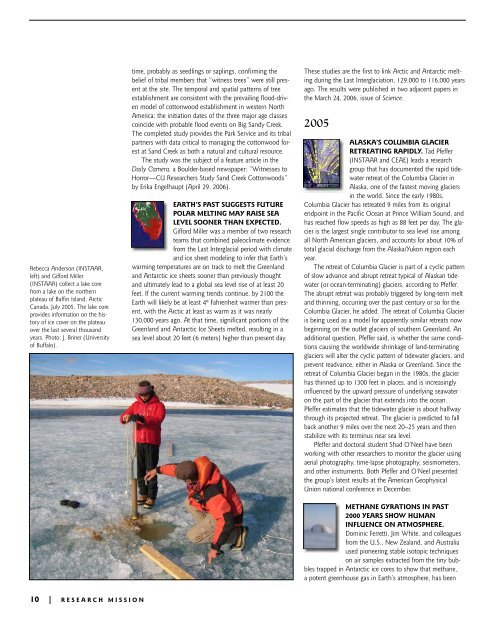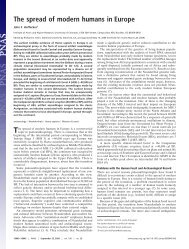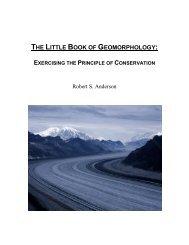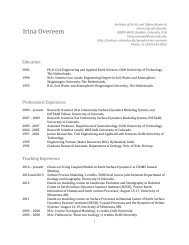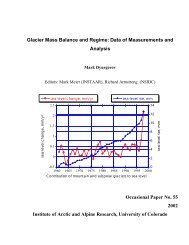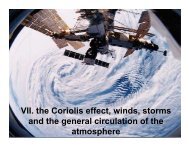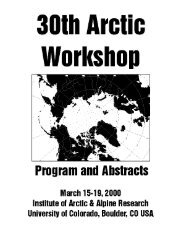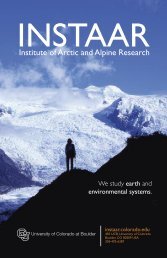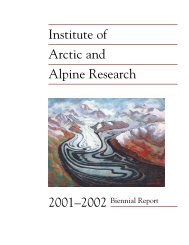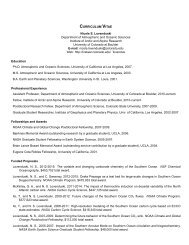Rebecca Anderson (<strong>INSTAAR</strong>,left) and Gifford Miller(<strong>INSTAAR</strong>) collect a lake corefrom a lake on the northernplateau <strong>of</strong> Baffin Island, ArcticCanada, July 2<strong>00</strong>5. The lake coreprovides information on the history<strong>of</strong> ice <strong>cover</strong> on the plateauover the last several thousandyears. Photo: J. Briner (<strong>University</strong><strong>of</strong> Buffalo).time, probably as seedlings or saplings, confirming thebelief <strong>of</strong> tribal members that “witness trees” were still presentat the site. The temporal and spatial patterns <strong>of</strong> treeestablishment are consistent with the prevailing flood-drivenmodel <strong>of</strong> cottonwood establishment in western NorthAmerica; the initiation dates <strong>of</strong> the three major age classescoincide with probable flood events on Big Sandy Creek.The completed study provides the Park Service and its tribalpartners with data critical to managing the cottonwood forestat Sand Creek as both a natural and cultural resource.The study was the subject <strong>of</strong> a feature article in theDaily Camera, a Boulder-based newspaper: “Witnesses toHorror—CU Researchers Study Sand Creek Cottonwoods”by Erika Engelhaupt (April 29, 2<strong>00</strong>6).EARTH’S PAST SUGGESTS FUTUREPOLAR MELTING MAY RAISE SEALEVEL SOONER THAN EXPECTED.Gifford Miller was a member <strong>of</strong> two researchteams that combined paleoclimate evidencefrom the Last Interglacial period with climateand ice sheet modeling to infer that Earth’swarming temperatures are on track to melt the Greenlandand Antarctic ice sheets sooner than previously thoughtand ultimately lead to a global sea level rise <strong>of</strong> at least 20feet. If the current warming trends continue, by 21<strong>00</strong> theEarth will likely be at least 4º Fahrenheit warmer than present,with the Arctic at least as warm as it was nearly130,<strong>00</strong>0 years ago. At that time, significant portions <strong>of</strong> theGreenland and Antarctic Ice Sheets melted, resulting in asea level about 20 feet (6 meters) higher than present day.These studies are the first to link Arctic and Antarctic meltingduring the Last Interglaciation, 129,<strong>00</strong>0 to 116,<strong>00</strong>0 yearsago. The results were published in two adjacent papers inthe March 24, 2<strong>00</strong>6, issue <strong>of</strong> Science.2<strong>00</strong>5ALASKA’S COLUMBIA GLACIERRETREATING RAPIDLY. Tad Pfeffer(<strong>INSTAAR</strong> and CEAE) leads a researchgroup that has documented the rapid tidewaterretreat <strong>of</strong> the Columbia Glacier inAlaska, one <strong>of</strong> the fastest moving glaciersin the world. Since the early 1980s,Columbia Glacier has retreated 9 miles from its originalendpoint in the Pacific Ocean at Prince William Sound, andhas reached flow speeds as high as 88 feet per day. The glacieris the largest single contributor to sea level rise amongall North American glaciers, and accounts for about 10% <strong>of</strong>total glacial discharge from the Alaska/Yukon region eachyear.The retreat <strong>of</strong> Columbia Glacier is part <strong>of</strong> a cyclic pattern<strong>of</strong> slow advance and abrupt retreat typical <strong>of</strong> Alaskan tidewater(or ocean-terminating) glaciers, according to Pfeffer.The abrupt retreat was probably triggered by long-term meltand thinning, occurring over the past century or so for theColumbia Glacier, he added. The retreat <strong>of</strong> Columbia Glacieris being used as a model for apparently similar retreats nowbeginning on the outlet glaciers <strong>of</strong> southern Greenland. Anadditional question, Pfeffer said, is whether the same conditionscausing the worldwide shrinkage <strong>of</strong> land-terminatingglaciers will alter the cyclic pattern <strong>of</strong> tidewater glaciers, andprevent readvance, either in Alaska or Greenland. Since theretreat <strong>of</strong> Columbia Glacier began in the 1980s, the glacierhas thinned up to 13<strong>00</strong> feet in places, and is increasinglyinfluenced by the upward pressure <strong>of</strong> underlying seawateron the part <strong>of</strong> the glacier that extends into the ocean.Pfeffer estimates that the tidewater glacier is about halfwaythrough its projected retreat. The glacier is predicted to fallback another 9 miles over the next 20–25 years and thenstabilize with its terminus near sea level.Pfeffer and doctoral student Shad O’Neel have beenworking with other researchers to monitor the glacier usingaerial photography, time-lapse photography, seismometers,and other instruments. Both Pfeffer and O’Neel presentedthe group’s latest results at the American GeophysicalUnion national conference in December.METHANE GYRATIONS IN PAST2<strong>00</strong>0 YEARS SHOW HUMANINFLUENCE ON ATMOSPHERE.Dominic Ferretti, Jim White, and colleaguesfrom the U.S., New Zealand, and Australiaused pioneering stable isotopic techniqueson air samples extracted from the tiny bubblestrapped in Antarctic ice cores to show that methane,a potent greenhouse gas in Earth’s atmosphere, has been10 | RESEARCH MISSION
altered by humans over the past 2<strong>00</strong>0 years. Atmosphericmethane (CH 4 ) varied as expected over the past few centurieswhen methane concentrations in the atmosphere roseby nearly 3<strong>00</strong>% and other greenhouse gas levels are knownto have increased sharply due to human influences. But theresults further back in time came as a shock. Measurements<strong>of</strong> the stable carbon isotopes in methane ( 13 C <strong>of</strong> CH 4 )fluctuated much more than expected before the industrialrevolution. The gyrating ratio combined with other geochemicalmeasurements are evidence for massive fires set byhumans clearing land for agriculture and hunting for at least2<strong>00</strong>0 years. A prominent feature is a huge drop in the 13 Cratio from ca. A.D. 15<strong>00</strong>–16<strong>00</strong>, and this was attributed todecreased grassland and forest burning by indigenous peoplesin the South and Central Americas, where populationwas devastated by diseases brought to the New World byEuropean explorers. The study is particularly importantbecause methane increases have had the second highestimpact on climate change over the past 250 years behindcarbon dioxide, accounting for about 20% <strong>of</strong> the warmingfrom all greenhouse gas increases. Methane is more powerfulthan carbon dioxide on a per molecule basis in slowingthe release <strong>of</strong> radiated heat away from Earth. Previous workby other groups indicates that methane emissions fromwildfires are likely to be higher during warm and dry periods,such as El Niño events, and may therefore increasewith future climate change.The paper was published in the September 9, 2<strong>00</strong>5,issue <strong>of</strong> Science. Image: Central field tent at Law Dome,Antarctica, where drilling took place. Snow accumulation atLaw Dome is very high (greater than 1 m/year), enablingthe extraction <strong>of</strong> well-dated, high-resolution ice cores forgreenhouse gas analysis. (Photo: Vin Morgan, AustralianAntarctic Division, ACE, CRC).ENVIRONMENTAL ENGINEERSSTUDY POLLUTION OF COLORADOMOUNTAIN STREAMS BY MINES.Diane McKnight (<strong>INSTAAR</strong> and CEAE) andJeff Wong (CEAE) spoke with radio stationKUNC’s Gavin McMeeking about the pervasivepollution <strong>of</strong> Colorado mountain streams by mining andthe potential for remediation by environmental engineers.More than 19,<strong>00</strong>0 abandoned mines in Colorado have pollutedmore than 75<strong>00</strong> miles <strong>of</strong> streams (equal to the distancefrom Los Angeles to Sydney, Australia). This summerMcKnight and Wong are concentrating on Peru Creek inSummit County (Snake River Watershed). The creek’s bednear an abandoned mine is <strong>cover</strong>ed by metal oxides at alevel that prevents algal growth and is lethal to aquatic life.There are no stream insects and thus, no fish or riparianbirds. To help understand the transport <strong>of</strong> metals, Wong setup a salt injection tracer experiment that mimics the behavior<strong>of</strong> some nonreactive solutes, such as zinc, and helps inquantifying how much iron oxide is being deposited.Undergraduate students in the CU Biomathematics Scholarsprogram based at <strong>INSTAAR</strong> participated in the downstreamsample collection. Computer modeling <strong>of</strong> the experiment’sdata will provide ideas for remediation, but much remains tobe learned and eventually millions <strong>of</strong> dollars will be neededto clean up this stream and many others. Ironically, anotherhurdle to successful remediation is the Clean Water Act,which mandates that any group working on remediationbecomes liable for the environmental damage. CongressmanMark Udall has proposed a “good samaritan” amendmentbut it has stalled in Congress. Two other <strong>INSTAAR</strong> gradstudents, Andrew Todd and Chi Yang (CEAE), are studyingthe combined effects <strong>of</strong> limited prey and metal toxicity onfish and birds in other less severely impacted stream reachesin the larger Snake River Watershed. The segment aired onKUNC on August 4, 2<strong>00</strong>5.ANCIENT DIETS OF AUSTRALIANBIRDS POINT TO BIG ECOSYSTEMCHANGES. Gifford Miller led an internationalteam (<strong>INSTAAR</strong>, CarnegieInstitution, Australian National <strong>University</strong>,Wollongong <strong>University</strong>, and BatesCollege) to dis<strong>cover</strong> that the diet <strong>of</strong> tw<strong>of</strong>lightless birds inhabiting Australia shifted soon afterhumans arrived ca. 50,<strong>00</strong>0 years ago, coincident with arapid and dramatic shift in the ecosystem’s flora. Their dis<strong>cover</strong>yis the best evidence yet that early humans may havealtered the continent’s interior with fire, changing it from amosaic <strong>of</strong> trees, shrubs, and grasses to the desert scrub evidenttoday. The researchers used isotopic studies <strong>of</strong> nearly15<strong>00</strong> eggshell fragments <strong>of</strong> fossilized emu and Genyornisdating back 140,<strong>00</strong>0 years. The analyses, which pinpointparticular plant groups ingested by the birds, indicated thatemus living before 50,<strong>00</strong>0 years ago preferred nutritiousgrasses characteristic <strong>of</strong> milder temperatures and warm sum-Tents dot the skyline at FladeIsblink, a small ice cap at 81°Nin NE Greenland, summer 2<strong>00</strong>6.Patterns in the surface hoardecorate the surface <strong>of</strong> the ice.Researchers from <strong>INSTAAR</strong> andthe Niels Bohr Institute at the<strong>University</strong> <strong>of</strong> Copenhagen drilledthe ice cap. Photo: Bruce Vaughn(<strong>INSTAAR</strong>).RESEARCH MISSION | 11
- Page 1 and 2: INSTAARInstitute of Arctic and Alpi
- Page 3 and 4: BiennialReport2005-2006Institute of
- Page 5 and 6: INSTAAR: An Earth andEnvironmental
- Page 7 and 8: CU-Denver campus where she helped t
- Page 9 and 10: Where in the world is INSTAAR? Acti
- Page 11: The instrument was deployed on NOAA
- Page 15 and 16: ties. However, manmade reservoirs a
- Page 17 and 18: Arctic WorkshopThe annual Arctic Wo
- Page 19 and 20: Wendy Roth (INSTAAR) explains the p
- Page 21 and 22: camera equipment. These laboratorie
- Page 23 and 24: Research Grants: Fiscal Years2004-2
- Page 25 and 26: Ogilvie, Astrid: NSF. HSD: Human an
- Page 27 and 28: Theses Completed2005Breiter, Nehale
- Page 29 and 30: Gifford MillerGEOL 1060, Global Cha
- Page 31 and 32: Lana Cohen, MS, Atmospheric and Oce
- Page 33 and 34: Trevor Popp, PhD, Geological Scienc
- Page 35 and 36: Societal Outreach andInformal Educa
- Page 37 and 38: A group of students from Southern H
- Page 39 and 40: Outreach SpotlightsUNDERGRADUATE ME
- Page 41 and 42: Spotlights: Honors, Awards,and Reco
- Page 43 and 44: TIM SEASTEDT WINS THE 2005PACESETTE
- Page 45 and 46: Structure of hierarchically organiz
- Page 47 and 48: William F. ManleyFellow of INSTAAR.
- Page 49 and 50: Alan R. TownsendFellow and Associat
- Page 51 and 52: GeophysicsEdmund AndrewsChief River
- Page 53 and 54: INSTAAR Visiting Scientists,2005-20
- Page 55 and 56: Chris JarosSupervisor: Diane McKnig
- Page 57 and 58: INSTAAR Noon SeminarsSpring 2005Tad
- Page 59 and 60: Graduate Student TalksSpring 2005Ry
- Page 61 and 62: Journal and BooksArctic, Antarctic,
- Page 63 and 64:
Publications2005Adams, P. N., Storl
- Page 65 and 66:
“El Nino suppresses Antarctic war
- Page 67 and 68:
European settlement of Lake Eyre, S
- Page 69 and 70:
tion of Baffin Island, Arctic Canad
- Page 71 and 72:
and soil quality for sustainable gr
- Page 73 and 74:
Andrews, J. T., Eberl, D. D., and K
- Page 75 and 76:
Cleveland C. C., Reed S. C., and To
- Page 77 and 78:
and Pierre Y. Julien. Journal of Hy
- Page 79 and 80:
Tributaries to the ColoradoRiver th
- Page 81 and 82:
Rocchi, S., LeMasurier, W. E., and


